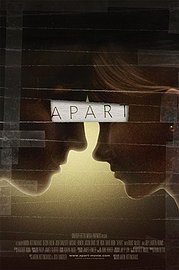 Problematic is any new film technology as its use becomes more pervasive, limits and controls are found as its boundaries are pushed. The advent of the Red One, allowing for filmmakers to “bake” in a look is distracting and startlingly in its artificiality while otherwise remaining grounded within the confines of the ‘real world’. This is the problem that is the major, and fetal flaw of Apart – an otherwise well-crafted and directed film by Aaron Rottinghaus, who previously worked as an editor (and continues his work here). This is a love story with horror elements and textures and it builds up a striking atmosphere that is ruined by the artificiality of the Red One, which adds digital texture and grain. Like the first digital projectors which looked artificial, the replication of reality is too slick, polished and animated. It doesn’t work within this context.
Problematic is any new film technology as its use becomes more pervasive, limits and controls are found as its boundaries are pushed. The advent of the Red One, allowing for filmmakers to “bake” in a look is distracting and startlingly in its artificiality while otherwise remaining grounded within the confines of the ‘real world’. This is the problem that is the major, and fetal flaw of Apart – an otherwise well-crafted and directed film by Aaron Rottinghaus, who previously worked as an editor (and continues his work here). This is a love story with horror elements and textures and it builds up a striking atmosphere that is ruined by the artificiality of the Red One, which adds digital texture and grain. Like the first digital projectors which looked artificial, the replication of reality is too slick, polished and animated. It doesn’t work within this context.
Told in three sections the film follows two lovers, Noah (co-writer Josh Danziger) and Emily (Olesya Rulin) linked by a psychological disorder called F.24. They grow co-dependent and destructive, the only solution is separation. The film takes place in three time periods – each with its own look that provides an orientation, the most artificial is the past. Noah awakes from a two-year coma in a love story driven by special effects and atmosphere that is largely responsible for its emotional content. Emily is seeing a psychologist (played by Joey Lauren Adams). Both Emily and Noah share a longing for each other and thus starts the back story. In the present, the texture of a small Texas town is correct. In its the past, a mediated experience that is somewhat problematic.

Driving the film forward is a series of visions, similar to the Twilight series (most notably New Moon). What builds in the uncanny valley of the Red One is a thriller of disconnection with well-crafted compositions and tenderness. The mystery unfolds and grows into a by-the-numbers romantic thriller, the secrets are expected as they arrive, and even before they arrive (such as the description of F. 24 that opens the film).
The non-linear structure works, and much is correct in Apart – however the over-produced look of the film, which turns what could have been a subtle love story into an indie version of a Zack Snyder film is over the top. It’s a major distraction from the powerful performances on screen.

